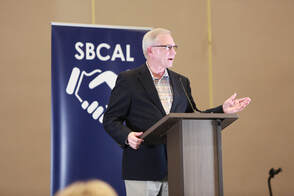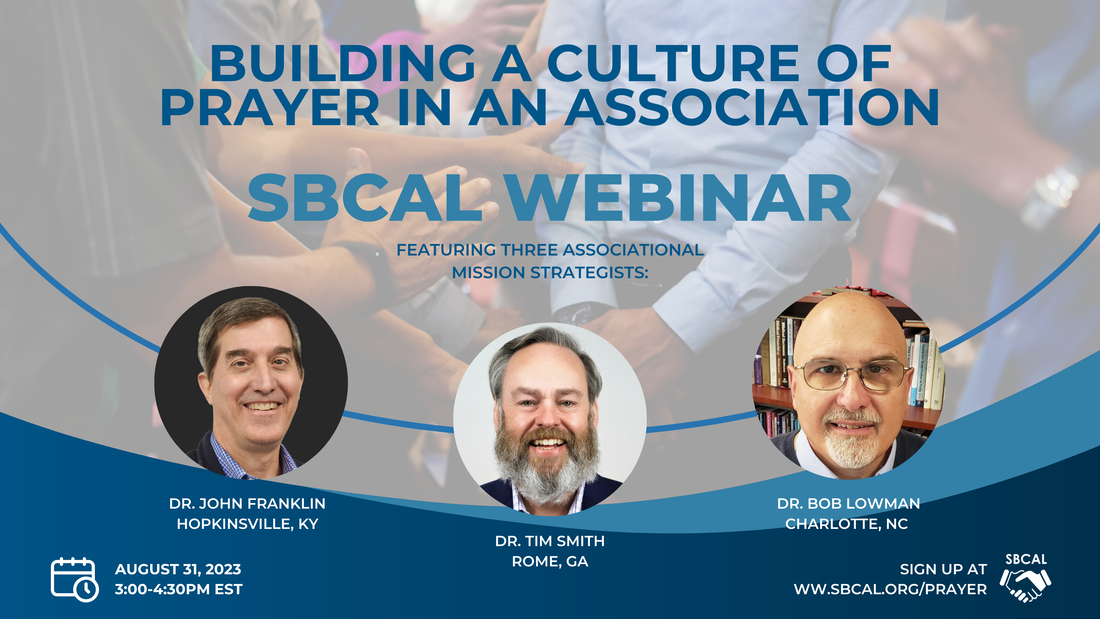Baptist Associations on the Rise Despite Their Predicted Demise
|
Here are Four Things to Know this Week:
Baptist Associations on the Rise Despite Their Predicted Demise
0 Comments
Building a Culture of Prayer in an Association - Webinar, 3:00-4:30pm EDT, August 31
Associations should be committed to prayer just like individuals and churches. I hope you will plan to hear from AMSs Dr. John Franklin, Dr. Tim Smith, and Dr. Bob Lowman discuss “Building a Culture of Prayer in an Association” on August 31. These men of prayer are advocates of prayer in their associations, but they do so in different ways. NAMB and SBCAL are partnering together to offer a Pre-Conference for New AMSs with less than two years in this role.
If you have already registered for the NAMB AMS Excellence Lab and want to attend this Pre-Conference, fill out the form below to be added to the group. If you have not registered yet, complete the form, and I will send you an invitation if the NAMB AMS Lab is not full. “Do you see a man skilled in his work? He will stand before kings; He will not stand before obscure men” (Proverbs 22:29 NASB).
Wise people learn from watching others and studying about their craft. The CSB Study Bible says about being skilled, “To be skilled is to be experienced, learned, efficient, and accurate in one’s vocation.” The Associational Leader Needs to Lead
When I first became an associational leader 30 years ago, the two terms “associational,” and “leader” were seldom, if ever, used together. We were either called “Associational Missionaries,” or “Directors of Missions.” I do not remember anyone calling me an “Associational Leader.”  Ray Gentry in New Orleans June 11, 2023, addressing the SBCAL Annual Conference. Picture provided by The Baptist Paper Ray Gentry in New Orleans June 11, 2023, addressing the SBCAL Annual Conference. Picture provided by The Baptist Paper 2023 SBCAL New Orleans Annual Conference President’s Address Thank you for being a member of SBCAL and for taking the time out of your busy schedule to spend this time with your peers. SBCAL is a grassroots network of associational leaders who come together to equip, encourage, and network for greater effectiveness and fruitfulness in God’s kingdom. In my role, I operate somewhat like an air traffic controller – offering direction, resourcing, and networking at your service. For example, just a few weeks ago, I received a call from Hawaii. I was able to connect them to an AMS in New York state who had a similar situation. He was happy to offer assistance to a volunteer associational leader in Hawaii. As AMSs, we know more about what we do than anyone else. Our Conference theme is “Leading with Integrity and Skill,” based on Ps. 78:72: “So he shepherded them according to the integrity of his heart, And guided them with his skillful hands” (NASB). Both integrity and skill are needed to lead our associations in godly, wise ways. SBCAL is here to help you do both.
Our Priorities are Leadership Equipping, Associational Advocacy, Development Pathways, and Succession Planning. Today I want to focus on two of those. Leadership Equipping – In April, we had a great Midwest Regional Conference. This coming year, we will explore the possibility of offering regional training in the West. In addition, we will see if there is enough interest to offer a two-day SBCAL Retreat in early March, 2025. There are a number of AMSs who love what we do, but for various reasons are unable to attend this annual conference each June. Therefore, we will see if there is interest in partnering with some state conventions and SBC entities to offer a retreat in addition to our annual conference on a trial basis. I look forward to offering more Virtual Conferences (webinars) on helpful topics after becoming full-time July 1. Plus, I would love to attend as many of your state AMS gatherings in person or by Zoom as I can. I want to listen and get to know you and your peers in your state – your challenges and your opportunities – and offer encouragement and be a help to you any way I can. Second, Development Pathways – We see a need to offer professional development pathways. One area we are already offering is coaching - specifically Gospel Coaching. If you have not been to this training, I encourage you to do so. We have a partnership with Tom Wood and Church Multiplication Ministries that offers a 20% discount on Gospel Coach training. A new pathway I am excited to initiate this fall will be SBCAL AMS Cohorts. These will be small groups of AMSs meeting for approximately an hour a month by Zoom for iron sharpening iron times across state lines about issues we face, studying helpful resources, and experiencing times of prayer, fellowship, and encouragement. Be on the lookout for more on this in the July Encourager newsletter. I would greatly appreciate it if you would add me to your prayer list. I want to glorify Christ and represent you and this association of associational leaders well. I want to serve you to the best of my ability. Thank you for allowing me to serve you part-time for 8 years. I am excited and looking forward to being able to do so full-time beginning in July.  I believe a helpful thing AMSs can do is to curate content for their pastors and church leaders – especially those who do not read widely and keep up with SBC and evangelical news and helps. In my (now weekly) blog, I will curate content for you to save you some time and effort. Here are “Four Helpful Things To Know” this week. I am sometimes asked, “How does an AMS start and lead Pastor Cohorts?” Related questions are “How do they work?” and “What are the nuts and bolts of Pastor Cohorts?”
In God’s kindness and providence, I am blessed to lead five Pastor Cohorts, a Discipleship Ministers Cohort, and a Children's Ministers Cohort each month this school year. I regularly hear how much the pastors and other participants appreciate these cohorts. We meet in either restaurants like Chick-fil-A, or around a conference table in my office. Since Covid, most meet at our office - which is centrally located. We meet for an hour to an hour and a half at 8:30am, 11:30am, or 7:00pm. Each cohort chooses the location that is best for them. I am going to do something different this month. If it is well received, I may make it a regular practice. I am going to share several “Things To Know.” I am basing it on how I have been sharing “Three Things To Know This Week” with my pastors for some time. I curate content as I read from many different sources each week, and then I share with them what I consider to be some of the best content. Beginning this month, I want to start doing something similar for you, my fellow AMSs.
Associational Mission Strategists (AMSs) are often asked to assist churches when one of their pastors leaves their church. They may be asked to fill the pulpit for one or more Sundays, train the Pastor Search Committee, and/or recommend Pulpit Supply, Interim Pastor Candidates, or Transitional Interim Pastor Candidates. They may even be asked to serve as the Interim Pastor, although some associations do not allow that option.
|
SubscribeAuthorI’m Ray Gentry, the President/CEO of the Southern Baptist Conference of Associational Leaders (SBCAL). I’ve served Southern Baptist churches & associations in various roles for over 35 years. I have served as an associational leader for five associations, starting in 1993. The most recent one being the Southside Baptist Network, McDonough, GA. Categories
All
|


 RSS Feed
RSS Feed
